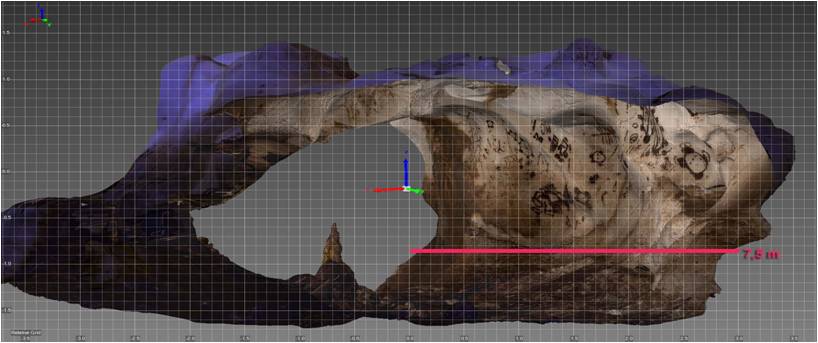Video Neolithic Mysteries: Revealing in 3D the Grotta dei Cervi in Porto Badisco (2009-2011), edited by Virginia Valzano (University of Salento), contains the backstage and the results of the Project "Grotta dei Cervi - Porto Badisco", a project initiated and coordinated by Virginia Valzano of acquisition and three-dimensional reconstruction and virtual representation realized in the years 2004-2010 in agreement with the Archaeological Superintendency of Puglia, with the collaboration of a team from the Canadian NRC and CASPUR of Rome.
Il video lesson it ranked first nationally in the section eScience and Technology of the Italian eContent Award 2009 and nominated for the World Summit Award 2011. It was awarded for the best content in digital format, for scientific rigour, methodology and innovative technological applications.
The Grotta dei Cervi in Porto Badisco is one of the most significant archaeological sites in Salento due to the presence of an extraordinary repertoire of Neolithic pictograms and the evidence of prehistoric human settlements over a long period of time.
The site extends for over 1.500 m along three main corridors whose walls are decorated with pictograms made with red ocher and, in greater numbers, with a mixture of ocher and bat guano. The paintings depict hunters, animals, magical symbols, abstract geometries and deer hunting scenes, from which the cave takes its name.
The Grotta dei Cervi is not easily accessible and is closed not only to the general public, but also to researchers, in order not to alter the delicate microclimate which has allowed the conservation of the painting so far.
The 2D and 3D digital acquisition (2005, 2009) of wall paintings and underground environments, difficult to access and with a high level of humidity, was extremely complex and required highly specialized skills and high-tech equipment suitable for use in extreme environmental.
The Grotta dei Cervi – Porto Badisco is a pioneering project that, 10-15 years ago, pushed 3D technology to higher levels. The large amount of high resolution 2D and 3D image data has opened the door to providing a 3D model of the caves with unmatched resolution, never before achieved in any 3D model of a cave site.
In 2005-2010 this was a major scientific milestone in the modeling of large and complex 3D environments.
The 3D textured model allows for virtual access to the site and pictograms without encroaching on the fragile environment of the Grotto.
Some parts of the cave are accessible in stereoscopy, in real time, in an immersive and interactive way, through the CEIT 3D Virtual Reality Theatre.
A detailed description of this Project, on the results obtained and on the best practices that emerged from this work, was presented and published in various Conferences and Proceedings and in the Conference held in Otranto in 2010.
For more information:
Videos “Neolithic Mysteries: Revealing in 3D the Grotta dei Cervi of Porto Badisco"
Virginia Valzano, Fabio Negro and Domenico Lucarella – “Otranto Treasures in 3D” (2019). in SCIRES-IT – SCIentific RESearch and Information Technology – 9(2) – 17-28
Video-Documentary "Treasures of Otranto in 3D"
Info
Virginia Valzano
Graduated in Philosophy at the University of Salento, she is a specialist in digital libraries and digital technologies applied to heritage; she is an expert in communication, digital content and knowledge management. From 1986 she was Director General of SIBA (University Library Information Services) and of the Telematic Information System for Research and Teaching of the University of Salento from 1986 until her retirement in 2010. She was also a lecturer at the Faculty of Cultural Heritage of the 'University of Salento in "IT Organization of Libraries".
She is engaged in the development of methodologies for the application of 2D, 3D and GIS digital technologies in the field of Cultural and Environmental Heritage and has coordinated numerous projects.
She is currently a consultant of the University of Salento and Director of the CEIT (Euro-Mediterranean Center of Technological Innovation for Cultural and Environmental Heritage and Biomedicine) University of Salento.
She is founder and Editor-in-Chief of the scientific journal Open Access SCIRES-IT – SCIentific RESearch and Information Technology.











Neolithic Mysteries: Revealing in 3D the Grotta dei Cervi of Porto Badisco – Virginia Valzano
The “Neolithic Mysteries: Revealing in 3D the Grotta dei Cervi of Porto Badisco” Video (2009-2011), edited by Virginia Valzano (University of Salento), contains the backstage and the results of the Project “Grotta dei Cervi – Porto Badisco” , a “Project of three-dimensional acquisition and reconstruction, and virtual representation” by Virginia Valzano, carried out in the years 2004-2010 in agreement with the Archaeological Superintendence of Puglia, with the collaboration of a team of Canadian NRC and the CASPUR of Rome.
The video was ranked first nationally in the “eScience and Technology” section of the Italian eContent Award 2009 and nominated for the World Summit Award 2011. It was awarded for the best content in digital format, for scientific rigour, methodology and innovative technological applications.
The “Grotta dei Cervi” (Deer Cave) of Porto Badisco (Otranto, Italy) is one of the most significant archaeological sites of the Salento region due to the presence of an extraordinary repertoire of Neolithic pictographs as well as the evidence of prehistoric human dwelling over a long period of time.
The site extends for more than 1,500 m., along three main corridors whose walls are decorated with pictograms done with red ochres and, in greater number, with a mixture of ochres and bat guano. The paintings depict hunters, animals, magical symbols, abstract geometries, and deer hunting scenes, after which the Cave is named.
The Grotta dei Cervi cannot be easily accessed and is closed not only to the general public, but also to researchers, so as not to alter the delicate micro climate which has so far allowed the conservation of the painting.
The 2D and 3D digital acquisition (2005, 2009) of wall paintings and hypogeum environments, hard to access and with a high humidity rate, was extremely complex and required highly specialized skills and high-tech equipment suitable for use in extreme environmental conditions.
The “Grotta dei Cervi – Porto Badisco is a pioneering project that, 10-15 years ago, pushed 3D technology to higher levels. The large amount of high-resolution 2D and 3D image data has opened the door to providing a 3D model of the caves of unmatched resolution, never obtained before in any 3D model of a cave site.
In the years 2005-2010 this was a major scientific milestone in modeling large and complex 3D environments.
The 3D textured model allows for a virtual access to the site and pictographs without invading the fragile environment of the Cave.
Some parts of the Cave can be accessed in stereoscopy, in real time, in immersive and interactive way, through the 3D Virtual Reality Theater of CEIT.
A detailed description of this Project, on the results obtained and the best practices emerging from this work, has been presented and published in various Conferences and Proceedings and in the Conference held in Otranto in 2010.
Virginia Valzano, Fabio Negro and Domenico Lucarella – “Otranto Treasures in 3D” (2019). in SCIRES-IT – SCIentific RESearch and Information Technology – 9(2) – 17-28
Video-Documentary "Treasures of Otranto in 3D"
Info
Virginia Valzano
Graduated in Philosophy at University of Salento, Virginia Valzano is specialist in Digital libraries and digital technologies as applied to heritage; she is an expert in communication, digital content and knowledge management.
She was the general director of SIBA (University Library Computer Services) and of the Telematic Information System for Research and Education of Salento University from 1986 until her retirement in 2010. She was also professor at the Faculty of Cultural Heritage of Salento University in “Library computer organisation”.
She is committed to the development of methodologies for the application of the digital technologies 2D, 3D and GIS in the field of Culture and Environmental Heritage and she coordinated numerous projects.
She has many publications in her field of expertise.
She is currently consultant of the University of Salento, Editor in Chief of SCIRES-IT – SCIentific RESearch and Information Technology.

